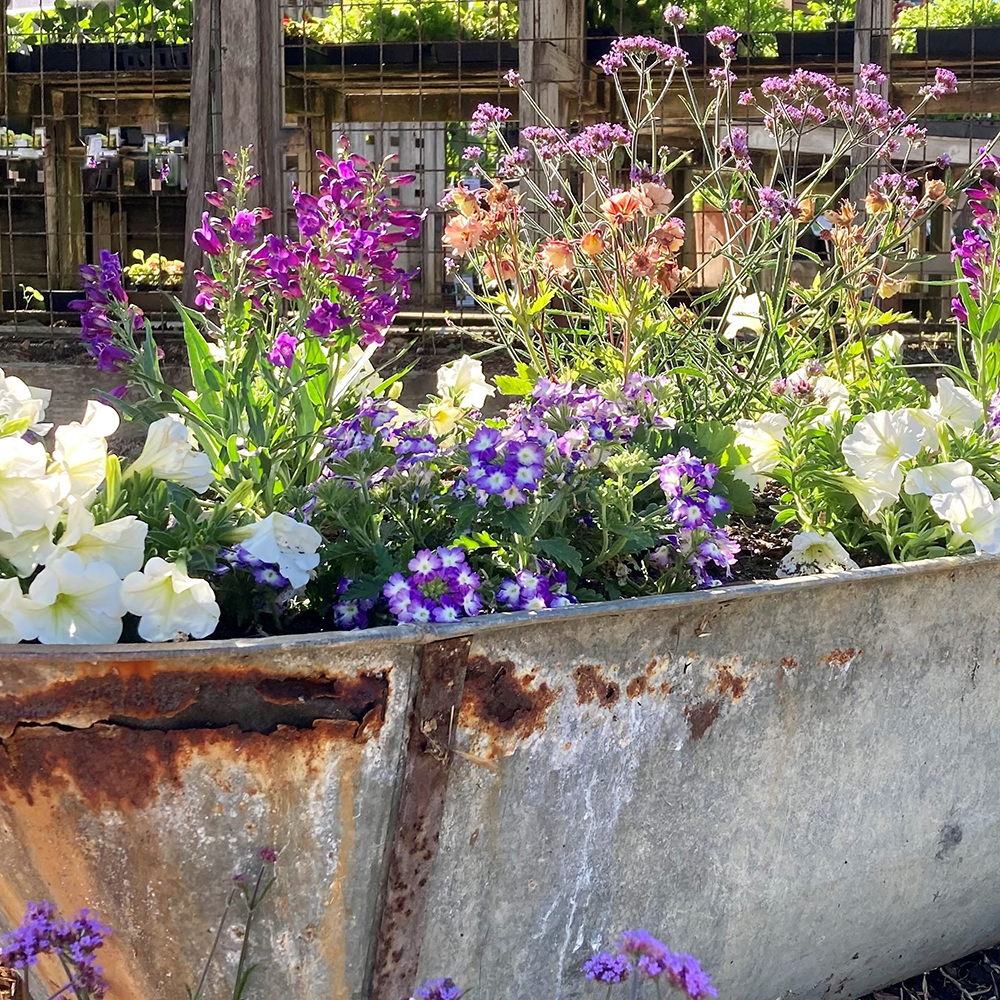
As summer approaches it will bring with it long and sunny days, increasingly warmer temperatures, and scorching conditions that can tip our region into heatwave territory.
Here on the Pacific Coast, we have had plentiful rain to replenish our groundwater sources this year, and our landscapes and plants have reflected this with abundant new growth, bumper spring crops, and bountiful blooms. Everything is ticking along nicely in our gardens right now, making it the perfect time to plan ahead and get ready for the inevitable summer heat. The following tips will help maintain the health of your plants and keep your garden thriving, not just surviving, throughout this summer and fall.

1. Add compost
Whether they’re in your vegetable patch, containers, or perennial beds, your plants’ root systems need adequate access to moisture all summer long to keep them flourishing. To ensure your soil is up to the task, enhance its moisture-holding qualities by digging in well-aged, organic compost. Not only does this add organic material, which soaks up and holds moisture longer, but it also improves soil structure, attracts beneficial organisms, and adds valuable nutrients.

2. Ensure your containers are properly equipped
Larger containers hold more soil and need less-frequent watering than smaller pots, which dry out faster on a hot day. For summer planting, store away your small pots for winter use, and make your life easier by just using larger pots (the bigger the better). Terra-cotta, concrete, and ceramic pots are all slower to warm up than plastic pots. Reflective metal or lighter-colored planters are less likely to absorb heat than darker containers. If it works for the plants, consider moving more heat-sensitive containers into shadier locations for the hottest months, or when you leave for any extended periods.

3. Install and check irrigation
Make sure you have a watering plan in place to keep your plants appropriately hydrated all summer long. A drip system is the most efficient way to ensure that moisture reaches directly to their root systems; plus, it uses less water than overhead watering. Educate yourself about the various irrigation systems available as well as your plants’ needs to ensure you have the right irrigation for each plant. For example, a 5-gallon drip emitter delivering water to a 4-inch succulent will drown the poor plant in no time. Already have a drip irrigation system in place? Now is the time to inspect it, paying attention to every tube and emitter in order to catch any leaks, breaks, or blockages that always seem to occur during winter. As wonderful as a drip system is, check it frequently during the season, and be sure to get out there with the garden hose during exceptionally hot spells. Regular, consistent water is essential for the survival of your garden during the summer months. Keep in mind that it is best to water early in the morning or late in the afternoon to minimize water loss through transpiration, and to avoid potential fungal problems.
4. Keep the weeds out
Weeds are resilient, opportunistic plants that will rob your precious plants of much-needed moisture, so it’s vital to nip that problem in the bud. Stay on top of weeding throughout the summer and into the fall.
5. Be sure to deadhead
Remove spent flowers regularly from all flowering shrubs and perennials. Setting seeds expends a lot of a plant’s energy, and your plants may already be stressed from hot summer temperatures.

6. Provide a little shade
Plan ahead and plant your more heat- and sun-sensitive annuals and vegetable crops in the shade of taller plants (sunflowers, towering tomatoes, fruit trees) if possible. Be ready with shade cloth or a sun umbrella during particularly scorching days.
7. Switch crops in the vegetable garden
Switch over to heat-loving summer crops (e.g., tomatoes, melons, cucumbers, squash, peppers, pumpkins, corn), and avoid planting cool-season vegetables (e.g., peas, brassicas, escarole, onions, chard) to ensure the best results from your veggie patch. Cool-season carrots, beets, and lettuces can be grown in afternoon shade all summer long (though they prefer full sun during the cooler months), but monitor for signs of bolting, and be sure to harvest while the leaves are young and tender.

8. Mulch, mulch, and mulch again
Mulch not only suppresses weeds and adds organic matter, but it also keeps soil temperatures cooler and reduces water loss from the soil’s surface. Avoid bare patches anywhere in the garden by adding a 3- to 4-inch layer of your favorite mulch to your perennial beds, flower borders, and vegetable garden.
9. Don’t forget the wildlife
Keep your garden’s wildlife population happy by topping up your birdbaths regularly so that feathered visitors can stay hydrated and bathe happily even on the hottest days. Well-placed rocks in your birdbaths allow bees and other pollinators to rest and quench their thirst too, while submerging a terra-cotta saucer filled with sand or soil right under an irrigation emitter creates the perfect watering hole for butterflies.
—Fionuala Campion is the owner and manager of Cottage Gardens of Petaluma in Petaluma, California.
Photos: Fionuala Campion
Fine Gardening Recommended Products

Gilmour 811673-1001 Sprinkler
Fine Gardening receives a commission for items purchased through links on this site, including Amazon Associates and other affiliate advertising programs.
- Adjustable collar for partial- to full-circle coverage
- Dial precisely sets spray distance
- On/off switch eliminates trips from sprinkler to spigot

Lee Valley Mini Garden Shear Set
Fine Gardening receives a commission for items purchased through links on this site, including Amazon Associates and other affiliate advertising programs.

Gilmour 5/8" x 25' Round Weeper Soaker Hose
Fine Gardening receives a commission for items purchased through links on this site, including Amazon Associates and other affiliate advertising programs.



















Comments
Log in or create an account to post a comment.
Sign up Log in